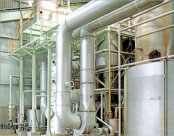About us
Okadora broke away from traditional technologies and created innovations in the meal plant sector.
Before the days of Sankyo Design, plants in the meal processing business were of old-fashioned design without any attention being paid to thermal efficiency and control. However, Sankyo Design was carrying out research towards control of pollution and in 1980 we developed the Waste Gas Recycle Plant. This new system takes the hot waste gas which is produced during the drying process and utilizes it to reduce the ‘cooking liquor’; and at the same time a dry gas is returned to the drying unit to confine the smells within the process.

Waste Gas Recycle Plant

Paddle Dryer System
At the same time Sankyo Design developed another essential system for the industry, which was to attract a lot of favourable attention. It is called the Paddle Dryer System. After recovering waste gases, it causes harmful odors and polluted water to be rendered non-toxic through a decomposition process.
In 1983 four further developments followed. The first innovation was the Waste Gas Evaporator, utilizing the concept of thin-layer gravity which originated from the Paddle Dryer System. The second was the Three-stage Effective Vacuum Evaporator, also using the thin-layer gravity method, and this proved more than doubly effective when compared to traditional evaporators. Another, bigger four-stage evaporator followed.

Film Membrane Gravity Type
Waste Gas Evaporator

Film Membrane Gravity Type
Triple Effect Vacuum Condenser
In August 1983, Sankyo Design developed the Three-stage Continuous Rendering Cooker, the first system of its kind in the world in the field of bone-meal production. This innovation clearly led on to another new system, the Steam Disc Dryer. The Steam Disc Dryer employed an indirect heating system by installing steam discs inside the shell. This process was able to turn out a higher quality of dried product than ever before.
With these successful developments under our belt, Sankyo Design was ready for the next big step.

Continuous Rendering Cooker

Steam Disc Dryer

